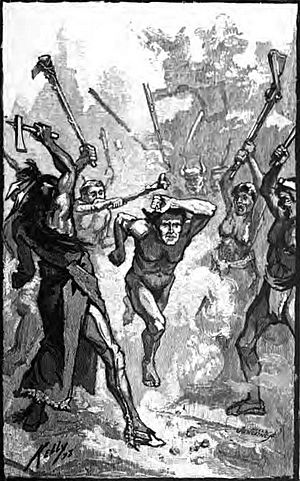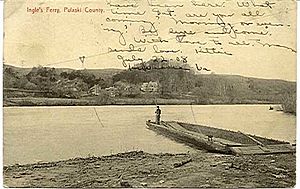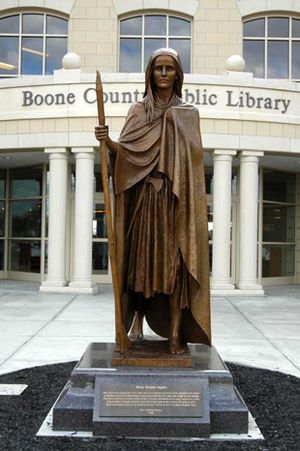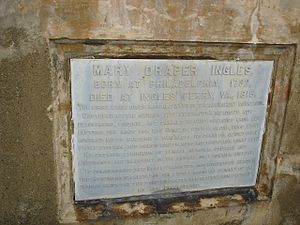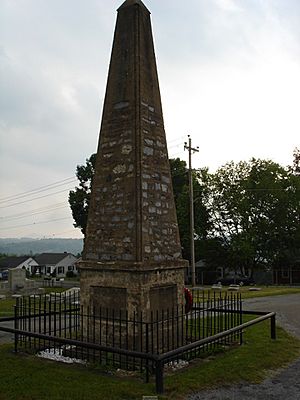Mary Draper Ingles facts for kids
Quick facts for kids
Mary Draper Ingles
|
|
|---|---|
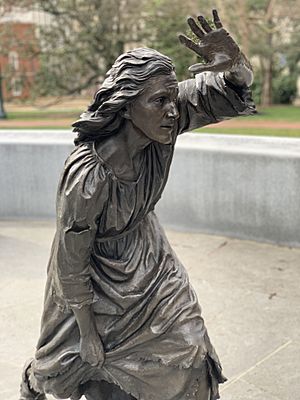
Statue of Mary Draper Ingles included in the Virginia Women's Monument.
|
|
| Born | 1732 Philadelphia, Pennsylvania, United States
|
| Died | 1 February 1815 (aged 82–83) |
| Known for | Escape from Indian captivity in 1755 |
| Parent(s) | George and Elenor (Hardin) Draper |
Mary Draper Ingles (born 1732, died 1815) was a brave American pioneer and early settler in western Virginia. In the summer of 1755, she and her two young sons were captured by Shawnee warriors. This happened after an attack known as the Draper's Meadow massacre during the French and Indian War.
Mary and her sons were taken far away to a Shawnee village called Lower Shawneetown. It was located where the Ohio and Scioto rivers meet. After about two and a half months, Mary escaped with another woman. They walked an amazing 500 to 600 miles. They crossed many rivers, creeks, and the Appalachian Mountains to get back home.
We know Mary's story from two main accounts. One was written by her son, John Ingles. The other was by Letitia Preston Floyd, who knew Mary. These stories show how incredibly tough and determined Mary was.
Contents
Biography
Mary's Early Life
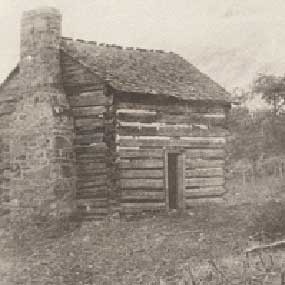
Mary Draper Ingles was born in 1732 in Philadelphia, Pennsylvania. Her parents, George and Elenor Draper, came to America from Donegal, Ireland in 1729.
Between 1740 and 1744, Mary's family moved to the western part of Virginia. They settled in Pattonsburg on the James River. Around 1744, Mary's father, George Draper, went on a trip and never came back.
In 1748 or 1750, her family started a new settlement called Draper's Meadow. It was a pioneer settlement near Blacksburg, Virginia.
In 1750, Mary married a fellow settler named William Ingles. They had two sons before Mary was captured: Thomas, born in 1751, and George, born in 1753. Later, after Mary returned, they had three daughters and another son.
The Attack at Draper's Meadow
On July 30, 1755, during the French and Indian War, a group of Shawnee warriors attacked Draper's Meadow. The Shawnee were allies of the French at that time.
They killed six settlers, including Mary's mother and her baby niece. The warriors took five people captive. These included Mary, her two sons, her sister-in-law Bettie Robertson Draper, and a neighbor named Henry Lenard. Mary's husband, William, almost died but managed to escape into the forest.
Life as a Captive
The Shawnee took their captives northwest along the New River. Then they followed the Ohio River. They traveled for a month until they reached Lower Shawneetown.
When they arrived, the prisoners had to go through a ritual called running the gauntlet. This meant they were whipped as they entered the town. However, Mary was not forced to do this.
Mary was separated from her sons. Shawnee families adopted them. Her oldest son, Thomas, was taken to Detroit. Her sister-in-law, Bettie, went to what is now Chillicothe, Ohio. Her youngest son, George, was taken to an unknown place and sadly died soon after.
While a prisoner, Mary sewed shirts for the Shawnee. She used cloth they got from French traders. In October 1755, Mary was taken to the Big Bone salt lick. There, she had to make salt for the Shawnee by boiling brine (salty water).
Mary's Great Escape
While working at Big Bone Lick in late October 1755, Mary convinced another captive woman to escape with her. The next day, they asked the Shawnee if they could go into the forest to gather wild grapes.
They set off, trying to follow the same route the Shawnee had taken when Mary was captured. They wore moccasins and carried only a tomahawk and a knife. They also had two blankets.
The women walked north, following the Ohio River. They expected the Shawnee to chase them, so they tried to hurry. But the Shawnee only searched briefly. They thought wild animals had taken the women.
After four or five days, the women reached the Ohio and Scioto rivers. They could see Lower Shawneetown in the distance. They found an empty cabin with some corn and an old horse. They took the horse to carry the corn, but it was lost in the river.
They followed the Ohio River, Kanawha River, and New River. They crossed many other rivers and creeks. It was amazing because neither woman could swim. Sometimes, they tied logs together with grapevines to make a raft. They may have traveled 500 to 600 miles.
When their corn ran out, they ate black walnuts, wild grapes, pawpaws, sassafras leaves, blackberries, roots, and frogs. As the weather got colder, they had to eat dead animals they found.
They saw Indians hunting several times but always managed to hide. Once, they found a deer that an Indian hunter had left behind. This gave them a much-needed meal.
As the journey continued, it started to snow, and the women were very weak from hunger. At one point, the other woman became very distressed and acted strangely, even trying to harm Mary. Mary managed to calm her down by promising money when they returned home.
Soon after, the other woman tried to harm Mary again. Mary managed to get away and ran into the forest. She hid until dark, then continued along the riverbank. She found a canoe and crossed the New River.
Mary kept going southeast along the riverbank. Four or five days after leaving the other woman, she reached the home of her friend Adam Harman. This was around December 1, 1755, 42 days after leaving Big Bone Lick. Soon after, a search party found the other woman.
Life After Her Escape
After recovering, Mary and her husband, William, continued farming. But they were worried about more Shawnee attacks. So, they moved to Fort Vause, a safer place. However, Mary still felt uneasy and convinced William to move again, this time to Bedford County, Virginia.
Mary likely shared information about Lower Shawneetown with her husband. He then suggested attacking the town to stop the Shawnee raids. William Ingles took part in the Sandy Creek Expedition in early 1756. But the group had to turn back because of bad weather and lack of food.
The Ingles family had four more children: Mary, Susanna, Rhoda, and John. In 1762, William and Mary started the Ingles Ferry across the New River. They also ran a tavern and blacksmith shop there. Mary died at Ingles Ferry in 1815, at 83 years old.

Mary's son George died while captive. But Thomas, who was 4 when captured, was returned to Virginia in 1768. He was 17 years old. After 13 years with the Shawnee, he spoke only Shawnee. He spent several years learning English and adjusting back to his old life.
Thomas Ingles later became a lieutenant in a war against the Shawnee. In 1782, his wife and three children were kidnapped by Indians. Thomas rescued them, but two of his older children were killed. His wife was hurt but survived.
In 1779, a British prisoner named Lord Henry Hamilton stayed at the Ingles' home. He wrote in his journal that Mary was still affected by her capture and escape, even 24 years later. He noted that she seemed sad, and her daughter often handled guests.
How We Know Mary's Story
The main ways we know about Mary Draper Ingles' journey are:
- An account written in 1824 by John Ingles, Mary and William's son.
- Parts of a letter from 1843 by Letitia Preston Floyd, who knew Mary.
- An article published in the New York Mercury newspaper in 1756. This article was based on a report from a traveler.
These stories have some small differences. This suggests that the Ingles and Preston families told the story a bit differently over time.
Mary Ingles in Books and Movies
Mary Ingles' amazing story has inspired many books and films:
- Follow the River (1995). This was a TV movie based on the novel.
- The Captives (2004), a film based on these events.
- The Long Way Home, an outdoor play performed every summer from 1971 to 1999. It told Mary's family history.
Remembering Mary Draper Ingles
Many places and monuments honor Mary Draper Ingles:
- On October 14, 2019, a statue of Mary Draper Ingles was dedicated at the Virginia Women's Monument in Richmond, Virginia.
- Radford University, near Draper's Meadow, has residence halls named Draper Hall and Ingles Hall.
- A statue of Mary Ingles was put up in the Radford Cultural Heritage Park in October 2016.
- A monument for Mary Draper Ingles is in West End Cemetery, Radford, Virginia. It was built using stones from the chimney of a home where she lived.
- Mary Ingles Elementary School in Tad, West Virginia is named after her.
- An 8-foot-tall bronze statue of Mary Draper Ingles is outside the Boone County Public Library in Burlington, Kentucky.
- Kentucky Route 8 in several counties is officially called "Mary Ingles Highway."
- Ingles Ferry and the Ingles Bottom Archeological Sites are listed on the National Register of Historic Places.
- The Virginia Tech library has documents that once belonged to Mary Draper Ingles.
- The Mary Draper Ingles Bridge crosses the New River in Summers County, West Virginia.
- The Mary Ingles Chapter of the National Society Daughters of the American Revolution is in Fort Thomas, Kentucky.


